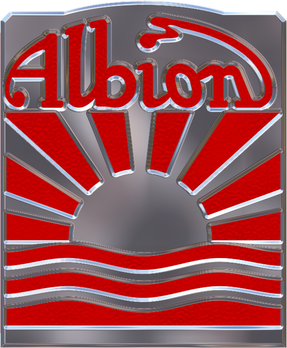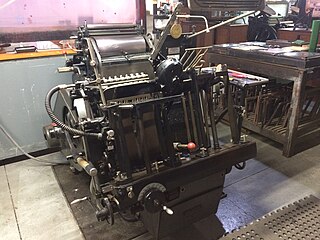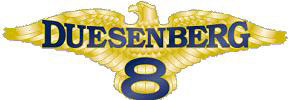
Lithography is a planographic method of printing originally based on the immiscibility of oil and water. The printing is from a stone or a metal plate with a smooth surface. It was invented in 1796 by the German author and actor Alois Senefelder and was initially used mostly for musical scores and maps. Lithography can be used to print text or images onto paper or other suitable material. A lithograph is something printed by lithography, but this term is only used for fine art prints and some other, mostly older, types of printed matter, not for those made by modern commercial lithography.

Printing is a process for mass reproducing text and images using a master form or template. The earliest non-paper products involving printing include cylinder seals and objects such as the Cyrus Cylinder and the Cylinders of Nabonidus. The earliest known form of printing as applied to paper was woodblock printing, which appeared in China before 220 AD for cloth printing. However, it would not be applied to paper until the seventh century. Later developments in printing technology include the movable type invented by Bi Sheng around 1040 AD and the printing press invented by Johannes Gutenberg in the 15th century. The technology of printing played a key role in the development of the Renaissance and the Scientific Revolution and laid the material basis for the modern knowledge-based economy and the spread of learning to the masses.

Reliant Motor Company was a British car manufacturer based in Tamworth, Staffordshire, England. It was founded in 1935 and ended car production in 2002, the company had been known as "Reliant Motor Company" until the 1990s when it became "Reliant Motors" and then finally became "Reliant Cars LTD" after production had ended of the Robin as the company was restructured to be a car import business. It is now a dormant company and the only entity left is a separate parts company created called "Reliant Partsworld" which produces parts for Reliant vehicles.

Digital printing is a method of printing from a digital-based image directly to a variety of media. It usually refers to professional printing where small-run jobs from desktop publishing and other digital sources are printed using large-format and/or high-volume laser or inkjet printers.

Offset printing is a common printing technique in which the inked image is transferred from a plate to a rubber blanket and then to the printing surface. When used in combination with the lithographic process, which is based on the repulsion of oil and water, the offset technique employs a flat (planographic) image carrier. Ink rollers transfer ink to the image areas of the image carrier, while a water roller applies a water-based film to the non-image areas.

Letterpress printing is a technique of relief printing for producing many copies by repeated direct impression of an inked, raised surface against individual sheets of paper or a continuous roll of paper. A worker composes and locks movable type into the "bed" or "chase" of a press, inks it, and presses paper against it to transfer the ink from the type, which creates an impression on the paper.

The Pontiac Fiero is a rear mid-engine, light sports car manufactured and marketed by Pontiac for model years 1984–1988.

Rotogravure is a type of intaglio printing process, which involves engraving the image onto an image carrier. In gravure printing, the image is engraved onto a cylinder because, like offset printing and flexography, it uses a rotary printing press.

Front-wheel drive (FWD) is a form of engine and transmission layout used in motor vehicles, in which the engine drives the front wheels only. Most modern front-wheel-drive vehicles feature a transverse engine, rather than the conventional longitudinal engine arrangement generally found in rear-wheel-drive and four-wheel-drive vehicles.

American Type Founders (ATF) Co. was a business trust created in 1892 by the merger of 23 type foundries, representing about 85 percent of all type manufactured in the United States at the time. The new company, consisting of a consolidation of firms from throughout the United States, was incorporated in New Jersey.

Albion Motors was a Scottish automobile and commercial vehicle manufacturer.

Manroland AG manufactures newspaper web offset presses, commercial web offset presses, and sheetfed offset presses for commercial, publications and packaging printing.

Minneapolis-Moline was a large tractor and farm and industrial machinery producer based in Minneapolis and Hopkins, Minnesota, Minnesota known for its Minneapolis-Moline tractor line. It was the product of a merger of three companies in 1929: Minneapolis Steel & Machinery (MSM) which was noted for its Twin City tractors, Minneapolis Threshing Machine Company (MTM) which also produced Minneapolis tractors, and the Moline Implement Company formerly known as the Moline Plow Company. It had manufacturing facilities on Lake Street at Hiawatha Avenue in Minneapolis, MN, in Hopkins, MN and in Moline, IL. Originally known as the Minneapolis-Moline Power Implement Company, and later shortened Minneapolis-Moline Company. Motec Industries was a short lived corporate name change from ca. 1960 until the companies acquisition by White Motor Corporation in 1963. <<prairiegoldrush.com>>
Purnell and Sons started out as a small family printers based in Somerset which merged with other printers over the next 100 years to become one the largest print groups in the UK and at one time a major publisher.

Edward Francis Eldred was a pioneer of scuba diving in Australia. He invented Porpoise scuba gear.
Gilson Graphics, Inc. is a commercial printing company in Grand Rapids, Michigan. Since its incorporation, Gilson Graphics has acquired selected assets of Knickerbocker Press, National Correct Color, Axis Digital Print and Imaging, Photolith, Commercial Printing Co., Hastings Press, and Integra Printing, Inc. Founded as Gilson Press Inc. in 1948 by Lars Gilson, the business now runs two locations in Grand Rapids and also operates a composition department in Atlantic, Iowa. Subsidiaries of the company include North Star Teacher Resources and Ignition New Media Workshop. The company is one of the largest printing companies in Grand Rapids.

Adana Printing Machines were manufactured from 1922 to 1999 in Twickenham, England. Although most of the printing presses produced by Adana were aimed at hobby printers, they were frequently put to commercial use. Adanas are still to be found throughout the world in the hands of colleges, enthusiasts and professional printers. Caslon Limited manufactured machines after a takeover of the company in 1987.

The Hamilton Wood Type and Printing Museum was founded in 1999 and is located in Two Rivers, Wisconsin, United States. The museum is run by the Two Rivers Historical Society. It is dedicated to the preservation, study, production and printing of wood type used in letterpress printing. The museum is located in a factory building of the Hamilton Manufacturing Company founded in 1880 by J.E. Hamilton. The museum has a collection of over 1.5 million pieces in more than 1,000 styles of wood type. Also included are presses and vintage prints. The museum holds many workshops and conferences throughout the year and regularly welcomes groups of students from universities from across the United States.

The Original Heidelberg Platen Press was a letterpress printing press manufactured by the Heidelberger Druckmaschinen company in Germany. It was often referred to as the Heidelberg Windmill, after the shape and movement of its paper feed system. When introduced, it was also called the "Super Heidelberg" or the "Super Speed".




















